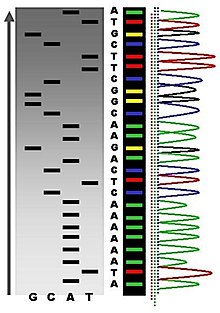Difference between revisions of "Week 2 YY"
imported>Youyoung Kim |
imported>Youyoung Kim |
||
| Line 2: | Line 2: | ||
<p><span style="font-family:comic sans ms,cursive"><span style="font-size:14px">DNA sequencing is the process of determining the nucleotide order of a given fragment.</span></span></p> | <p><span style="font-family:comic sans ms,cursive"><span style="font-size:14px">DNA sequencing is the process of determining the nucleotide order of a given fragment.</span></span></p> | ||
| − | |||
| − | |||
<p><span style="font-family:comic sans ms,cursive"><span style="font-size:14px">1. Sanger sequencing</span></span></p> | <p><span style="font-family:comic sans ms,cursive"><span style="font-size:14px">1. Sanger sequencing</span></span></p> | ||
| Line 17: | Line 15: | ||
<p><span style="font-size:14px"><span style="font-family:comic sans ms,cursive">Next-generation sequencing is the catch-all term used to describe a number of different modern sequencing technologies including Illumina sequencing, Roche 454 sequencing, Ion torrent: Proton/ PGM sequencing, and SOLiD sequencing. These recent technologies allow us to sequence DNA and RNA much more quickly and cheaply than the previously used Sanger sequencing, and as such have revolutionised the study of genomics and molecular biology.</span></span></p> | <p><span style="font-size:14px"><span style="font-family:comic sans ms,cursive">Next-generation sequencing is the catch-all term used to describe a number of different modern sequencing technologies including Illumina sequencing, Roche 454 sequencing, Ion torrent: Proton/ PGM sequencing, and SOLiD sequencing. These recent technologies allow us to sequence DNA and RNA much more quickly and cheaply than the previously used Sanger sequencing, and as such have revolutionised the study of genomics and molecular biology.</span></span></p> | ||
| − | <p> | + | <p> </p> |
| − | <p> | + | <p><span style="font-size:14px"><span style="font-family:comic sans ms,cursive">In addition, there are other types of sequencing such as methyl-seq or ATAC-seq.</span></span></p> |
<p> </p> | <p> </p> | ||
| − | |||
| − | |||
Revision as of 23:59, 30 November 2016
What is Sequencing?
DNA sequencing is the process of determining the nucleotide order of a given fragment.
1. Sanger sequencing

Sanger sequencing is a method of DNA sequencing based on the selective incorporation of chain-terminating dideoxynucleotides(ddNTPs) by DNA polymerase during in vitro DNA replication. This method was developed by Fredric Sanger and colleagues in 1977.
2. Next-generation sequencing (NGS)

Next-generation sequencing is the catch-all term used to describe a number of different modern sequencing technologies including Illumina sequencing, Roche 454 sequencing, Ion torrent: Proton/ PGM sequencing, and SOLiD sequencing. These recent technologies allow us to sequence DNA and RNA much more quickly and cheaply than the previously used Sanger sequencing, and as such have revolutionised the study of genomics and molecular biology.
In addition, there are other types of sequencing such as methyl-seq or ATAC-seq.